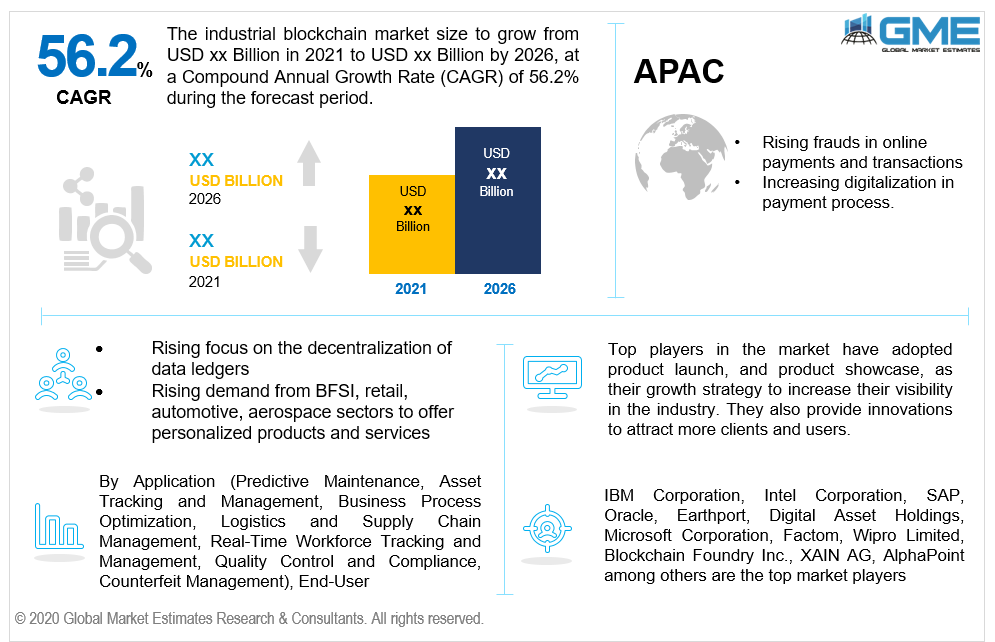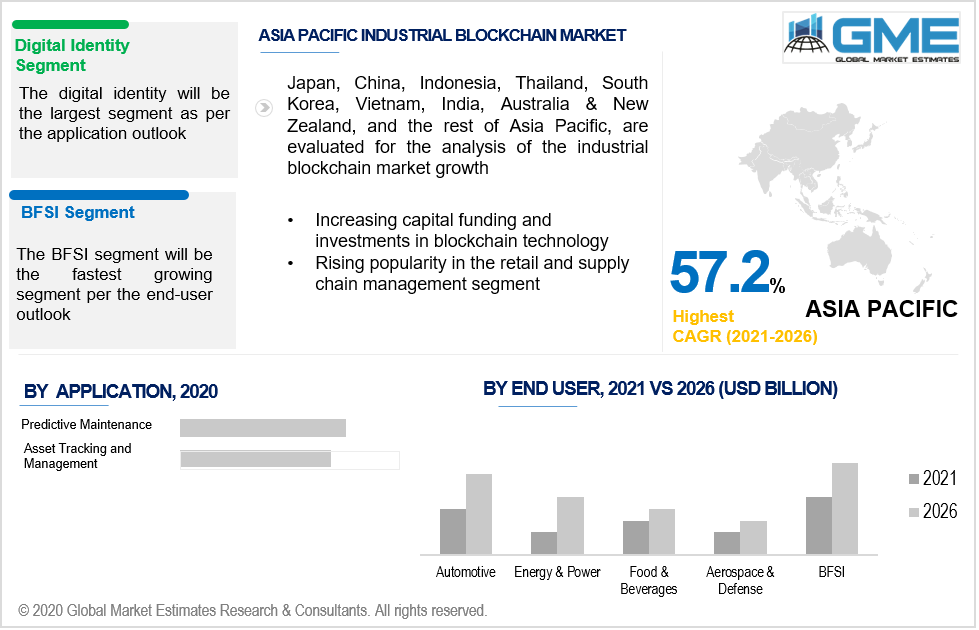
Industrial Blockchain Market Size, Trends & Analysis - Forecasts to 2026 By Application (Predictive Maintenance, Digital Identity, Asset Tracking and Management, Business Process Optimization, Payments Logistics, and Supply Chain Management, Real-Time workforce Tracking and Management, Quality Control and Compliance, Counterfeit Management and Other Applications), End-User (Banking Financial Service and Insurance [BFSI], Automotive, Energy & Power, Food & Beverages, Aerospace & Defence and Other End Users) Competitive Landscape, Company Market Share Analysis, and Competitor Analysis
With the increasing development in technology for e-commerce trade, online transaction, digital market etc., the money transaction has now become digitalized. The transactions and payments are done digitally through digital payment systems through government currencies, like the dollar or euro. This has begun to change as cryptocurrency technology is gaining popularity in the market. The biggest one by far, is bitcoin, a form of electronic cash that can be tracked each time the money changes person to person and a note can be kept to be on a safer side. Like the digital transactions taking place in the finance industry, the transactions in manufacturing supply chains are also becoming.
Blockchain, or prevalently known as Distributed Ledger Technology (DLT), makes the exchanges of any advanced resource protected, irreversible and straightforward using decentralization and cryptographic hashing which produces yield like hash which is an encoded text. For instance, in Google Docs, when we create any document, it is shared with everyone and not copied to everyone. Every person can make changes to the document at the same time without waiting for another person to log out of the document and people can work simultaneously. This makes the document transparent. Also, the changes are recorded in real-time format. The critical ideas of blockchain technology are the asset is decentralized i.e allowing users real-time access; digital assets are distributed instead of copied or transferred and hence work can be done simultaneously on a document; and a transparent ledger created, to prevent the integrity of the document and gain trust in the asset.
Blockchain is a very convincing and promising technology as it helps reduce the risk, stamps of frauds, and other betrayals and brings transparency in an efficient way for the users. The general purpose of utilizing a blockchain is to allow individuals to share important information safely and straightforwardly, particularly for individuals who don't confide in each other. Hence, concerns related to data security will boost the market growth.
The three major concepts are nodes, miners and blocks. Every chain consists of many blocks and each block has three basic elements: A 32-bit whole number is called a nonce, which is generated randomly whenever a block is created, which further generates a header hash. Miners do make new blocks on the chain, which is called mining. Every block has its unidentical nonce and hash, but it also refers to the hash of previous blocks in the chain and hence mining becomes a difficult job. Decentralization is an important concept in blockchain and one computer or one organization cannot own the chain. Nodes are any type of electronic device, which keeps the copy of the chain and also keeps the network functioning.
There are various benefits attached to blockchain such as it reduces costs of recalls, reduces friction from trade and shipping documents, helps in brand protection and saves from the adverse impact on revenue, enables trust selling. Blockchain gives different key highlights that make it an extremely valuable innovation for mechanical organizations. It includes rapid visibility, smart contracts, data integrity, and self-governance.
Rising popularity and adoption of Distributed Ledger Technology (DLT), is one of the prime driving factor for the market growth. The industries that drive the market for blockchain are BFSI, government, manufacturing, retail & consumer goods, travel & transportation, energy, and utilities. The major market challenge of industrial blockchain is online data breaching threats and security issues.

Based on the application of the industrial blockchain, the market is divided into digital identity, asset tracking, and management, predictive maintenance, business process optimization, real-time workforce tracking and management, logistics and supply chain management, quality control and compliance, counterfeit management and others. The digital identity segment will be growing faster than other segments. The segment would be growing with the rising number of online payment frauds and cyber-attacks happening worldwide.
The market based on end-user is segmented into banking, financial services and insurance (BFSI), automotive, energy & power, food & beverages, aerospace & defence and other end users. The banking, financial services, and insurance (BFSI) industry are expected to capture the largest market share and grow in terms of the market value in the blockchain market during the forecast period. This sector in particular has realized the importance of blockchain technology, which helps in keeping transactions secured for customers. The banking and financial service sector (BFSI) will become considerably grow more worldwide, because of different factors such as, similar to high similarity with the monetary administrations industry, rising digital currencies, and ascending in quick exchanges.

Based on region, the market is classified into North America (includes US, Mexico, and Canada) (NA), Europe (EU), South America (SA), Middle East & Africa (MEA), and Asia Pacific (APAC). The North American region will be the dominant segment majorly due to the increasing adoption of the latest digital technology in all the sectors, and high awareness regarding e-payments. However, the Asia Pacific segment will be the fastest-growing segment owing to the growing financial sector of countries like China, India and others. Also increasing research activities related to blockchain technology will support the growth of this region.
The major players in the industrial blockchain market are IBM Corporation, Intel Corporation, SAP, Oracle, Earthport, Digital Asset Holdings, Microsoft Corporation, Factom, Wipro Limited, Blockchain Foundry Inc., XAIN AG, AlphaPoint, and others.
Please note: This is not an exhaustive list of companies profiled in the report.
In the first quarter of 2019, Amazon Web Services launched Amazon Quantum Ledger Database (QLDB) and Amazon Managed Blockchain.
We value your investment and offer free customization with every report to fulfil your exact research needs.
The Global Industrial Blockchain Market has been studied from the year 2019 till 2026. However, the CAGR provided in the report is from the year 2021 to 2026. The research methodology involved three stages: Desk research, Primary research, and Analysis & Output from the entire research process.

The desk research involved a robust background study which meant referring to paid and unpaid databases to understand the market dynamics; mapping contracts from press releases; identifying the key players in the market, studying their product portfolio, competition level, annual reports/SEC filings & investor presentations; and learning the demand and supply-side analysis for the Industrial Blockchain Market.

The primary research activity included telephonic conversations with more than 50 tier 1 industry consultants, distributors, and end-use product manufacturers.

Finally, based on the above thorough research process, an in-depth analysis was carried out considering the following aspects: market attractiveness, current & future market trends, market share analysis, SWOT analysis of the company and customer analytics.

Tailor made solutions just for you
80% of our clients seek made-to-order reports. How do you want us to tailor yours?
OUR CLIENTS